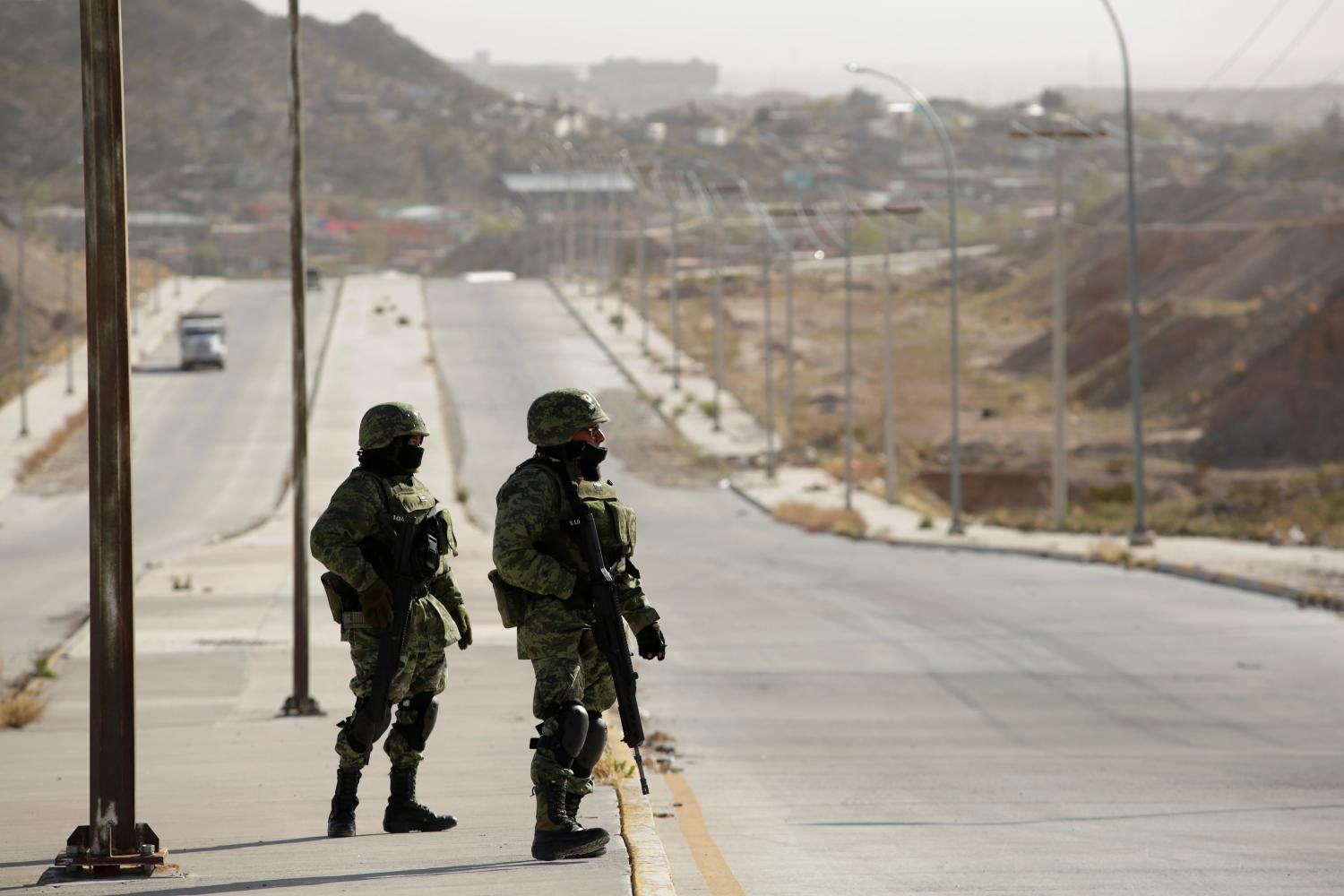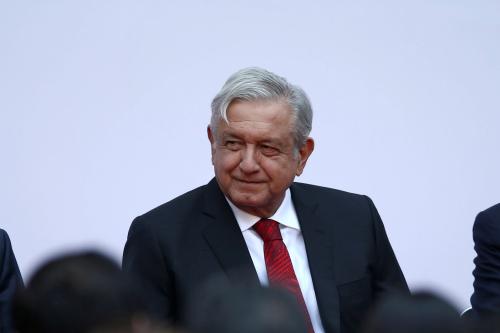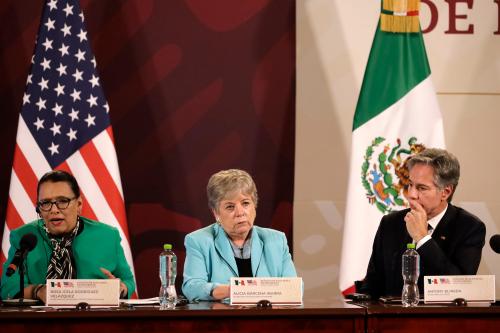Executive Summary
- This paper explores the trends, characteristics, and changes in the Mexican criminal market, in response to internal changes, government policies, and external factors. It explores the nature of violence and criminality, the behavior of criminal groups, and the effects of government responses.
- Over the past two decades, criminal violence in Mexico has become highly intense, diversified, and popularized, while the deterrence capacity of Mexican law enforcement remains critically low. The outcome is an ever more complex, multipolar, and out-of-control criminal market that generates deleterious effects on Mexican society and makes it highly challenging for the Mexican state to respond effectively.
- Successive Mexican administrations have failed to sustainably reduce homicides and other violent crimes. Critically, the Mexican government has failed to rebalance power in the triangular relationship between the state, criminal groups, and society, while the Mexican population has soured on the anti-cartel project.
- Since 2000, Mexico has experienced extraordinarily high drug- and crime-related violence, with the murder rate in 2017 and again in 2018 breaking previous records.
- The fragmentation of Mexican criminal groups is both a purposeful and inadvertent effect of high-value targeting, which is a problematic strategy because criminal groups can replace fallen leaders more easily than insurgent or terrorist groups. The policy also disrupts leadership succession, giving rise to intense internal competition and increasingly younger leaders who lack leadership skills and feel the need to prove themselves through violence.
- Focusing on the middle layer of criminal groups prevents such an easy and violent regeneration of the leadership. But the Mexican government remains deeply challenged in middle-layer targeting due to a lack of tactical and strategic intelligence arising from corruption among Mexican law enforcement and political pressures that makes it difficult to invest the necessary time to conduct thorough investigations.
- In the absence of more effective state presence and rule of law, the fragmentation of Mexican criminal groups turned a multipolar criminal market of 2006 into an ever more complex multipolar criminal market. Criminal groups lack clarity about the balance of power among them, tempting them to take over one another’s territory and engage in internecine warfare.
- The Mexican crime market’s proclivity toward violence is exacerbated by the government’s inability to weed out the most violent criminal groups and send a strong message that they will be prioritized in targeting.
- The message has not yet sunk in that violence and aggressiveness do not pay. For example, the destruction of the Zetas has been followed by the empowerment of the equally aggressive Cártel de Jalisco Nueva Generación (CJNG). Like the Zetas, the Jalisco group centers its rule on brutality, brazenness, and aggressiveness. Like the Zetas and unlike the Sinaloa Cartel, the CJNG does not invest in and provide socio- economic goods and governance in order to build up political capital.
- Equally, the internal rebalancing among criminal groups has failed to weed out the most violent groups and the policy measures of the Mexican governments have failed to reduce the criminal groups’ proclivity toward aggression and violence.
- The emergence of the CJNG has engulfed Mexico and other supply-chain countries, such as Colombia,in its war with the Sinaloa Cartel.
- The war between the Sinaloa Cartel and CJNG provides space for local criminal upstarts, compounds instability by shifting local alliances, and sets off new splintering within the two large cartels and among their local proxies.
- To the extent that violence has abated in particular locales, the de-escalation has primarily reflected a “narcopeace,” with one criminal group able to establish control over a particular territory and its corruption networks. It is thus vulnerable to criminal groups’ actions as well as to high-value targeting of top drug traffickers.
- In places such as Ciudad Juárez, Tijuana, and Monterrey, local law enforcement and anti-crime socio-economic policies helped in various degrees to reduce violence. When the narcopeace was undermined, the policies proved insufficient. At other times, the reduction of violence that accompanied a local narcopeace gave rise to policy complacency and diminished resources.
- Socio-economic policies to combat crime have spread resources too thinly across Mexico to be effective.
- Violence in Mexico has become diversified over the past decade, with drug trafficking groups becoming involved in widespread extortion of legal businesses, kidnapping, illegal logging, illegal fishing, and smuggling of migrants. That is partially a consequence of the fragmentation, as smaller groups are compelled to branch out into a variety of criminal enterprises. But for larger groups, extortion of large segments of society is not merely a source of money, but also of authority.
- Violence and criminality have also become “popularized,” both in terms of the sheer number of actors and also the types of actors involved, such as “anti-crime” militias.
- Widespread criminality increases the coercive credibility of individual criminals and small groups, while hiding their identities. Low effective prosecution rates and widespread impunity tempt many individuals who would otherwise be law-abiding citizens to participate in crime.
- Anti-crime militias that have emerged in Mexico have rarely reduced violence in a sustained way. Often, they engage in various forms of criminality, including homicides, extortion, and human rights abuses against local residents, and they undermine the authority of the state.
- Government responses to the militias—including acquiescence, arrests, and efforts to roll them into state paramilitary forces—have not had a significant impact.
- In fact, the strength and emergence of militia groups in places such as Michoacán and Guerrero reflect a long-standing absence of the government, underdevelopment, militarization, and abuse of political power.
- In places such as Guerrero, criminality and militia formation has become intertwined with the U.S. opioid epidemic that has stimulated the expansion of poppy cultivation in Mexico.
- The over-prescription of opioids in the United States created a major addiction epidemic, with users turning to illegal alternatives when they were eventually cut off from prescription drugs. Predictably, poppy cultivation shot up in Mexico, reaching some 30,000 hectares in 2017.
- Areas of poppy cultivation are hotly contested among Mexican drug trafficking groups, with their infighting intensely exacerbating the insecurity of poor and marginalized poppy farmers.
- Efforts to eradicate poppy cultivation have often failed to sustainably reduce illicit crop cultivation and complicated policies to pacify these areas, often thrusting poppy farmers deeper into the hands of criminal groups that sponsor and protect the cultivation.
- Eradication is easier than providing poppy farmers with alternative livelihoods. Combined with the Trump administration’s demands for eradication, the Enrique Peña Nieto administration, and Mexico historically, showed little interest in seriously pursuing a different path.
- Poppy eradication in Mexico does not shrink the supply of illegal opioids destined for the U.S. market, since farmers replant poppies after eradication and can always shift areas of production.
- The rise of fentanyl abuse in the United States, however, has suppressed opium prices in Mexico. Drug trafficking organizations and dealers prefer to traffic and sell fentanyl, mostly supplied to the United States from China, because of its bulk-potency-profit ratio.
- The CJNG became a pioneer in fentanyl smuggling through Mexico into the United States, but the Sinaloa Cartel rapidly developed its own fentanyl supply chain. Although the drug is deadly, the Sinaloa Cartel’s means of distribution remain non- violent in the United States. Fentanyl enters the United States from Mexico through legal ports of entry.
- In the short term, fentanyl has not altered the dynamics of Mexico’s criminal market, but in the long term, fentanyl can significantly upend global drug markets and the prioritization of drug control in U.S. agendas with other countries. If many users switch to synthetic drugs, the United States may lose interest in promoting eradication of drug crops. Such a switch would also weaken the power of criminal and insurgent groups who sponsor illicit crop cultivation. Even if they switch to the production of synthetic drugs, they will only have the capacity to sponsor the livelihoods of many fewer people, thus diminishing their political capital with local populations and making it less costly for the government to conduct counternarcotics operations.
- Mexico’s violence can decline in two ways. First, a criminal group can temporarily win enough turf and establish enough deterrence capacity to create a narcopeace, as has been the case so far. Alternatively, violence can decline when the state at last systematically builds up enough deterrence capacity against the criminals and realigns local populations with the state, from which they are now often alienated. Mexico must strive to achieve this objective.





